Chapter 01 : Our Environment
Welcome to Chapter One. When you were in Standard Two, you learned how to identify different domestic and wild animals. You also learned about dangerous organisms in the environment. In this chapter, you will learn how to conserve home and school environments. You will also learn about things found in home and school environments. In addition, you will learn how to clean your classroom and the school environment. Moreover, you will learn the importance of a clean environment. You will also learn stages of planting grass, trees, and flowers. Finally, you will learn how to care for such grass, trees, and flowers.
Things found in the environmentThe environment includes everything found in our surroundings. We are also part of the environment. Things which are found in the environment are divided into two groups. These are living and non-living things.
Living thingsLiving things refer to all things that can grow, move, breathe, reproduce, and die. Examples of living things are people, birds, cows, and trees.
Non-living thingsNon-living things refer to all things that cannot grow, move, breathe, reproduce, or die. Examples of non-living things are houses, roads and stones.
Observe Figures l , 2 and 3 and then answer the questions.
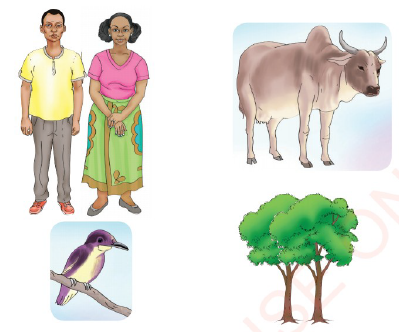 Fig. 1 Living things |
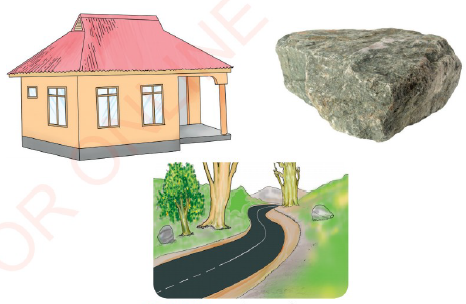 Fig. 2 Non-living things |
Things found in our home environment
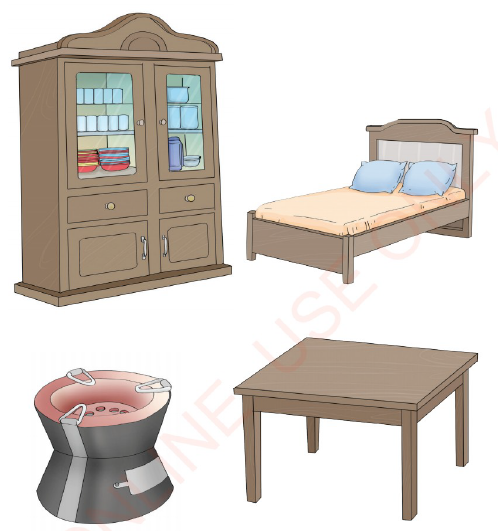 |
| Figure 3 Things found in our home environment |
Questions
1. Mention three things found in your home environment.
2. Mention three things found in your home environment, but ore not in Figure 3.
3. Mention four living things found in your home environment
Things found in the school environment
Observe Figure 4 then answer the questions.
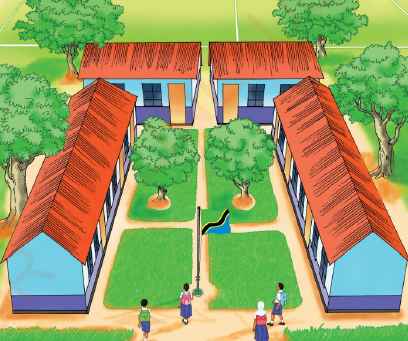 |
| Figure 4 The school environment |
Questions
1. Mention different things that are found in your school environment.
2. Mention two nonliving things found in Figure 4.
3. Mention two living things found in Figure 4.
4. Mention nonliving things found in your home environment.
5. Mention the importance of the things found in Figure 4.
6. Mention things found in your school environment that resemble those in Figure 4.
7. Which things are found In your school environment but are not In Figure 4?
Choose the correct answer and write n tn the space presided
8. Two groups of things found in the environment are . . . . . and . . . . .
- a rood and a house.
- living things and nonliving things.
- flowers and trees.
9. Living things are . . . . . . and . . . . . .
- trees and cars.
- stones and birds.
- humans and animals.
Kisomola Primary School environment
Rabia and Kaluza are in Standard Three at Kilimani Primary School. One Monday morning, their Head teacher sent them to a neighbouring school called Kisomola. They had to take a Standard Seven graduation invitation letter to the Head teacher.
Read the following conversation and then answer the questions that follow.
Head teacher Rabia and Kaluza, take this letter to Kisomola Primary School.
Rabia Yes Sir. To whom should we give the letter?
Head teacher Give it to the head teacher. (Kaluza and Rabia took the letter and left.)
Kaluza I can see we are near the school.
Rabia It is true. We are at Kisomola Primary School. There are many birds and trees.
Kaluza Aaah! Their school has more trees that provide shade than our school. The trees provide fresh air as well.
Rabia Hey, look at their flower garden! It is well arranged, and it makes the school look beautiful and clean.
Kaluza Ee! Look at the school sign-board. Its name has been written neatly!
Rabia They also have a big playground for sports and games. Can you see it?
Kaluza Yes, I can see it. It is a nice playground. Rabia, can you see the vegetable garden on the left side of the ground?
Rabia Yes, I can see it. They sell vegetables and earn a lot of money.
Kaluza Have you seen their classroom buildings and teachers' office? They look so nice!
Rabia Yes, I have seen them. The buildings are well painted. There are maps and other decorations on the walls.
Kaluza They also have a water well.
Rabia That is true. That is why their school flower and vegetable gardens have flourished.
After this conversation, Rabia and Kaluza went to the Head teacher's office. They greeted him and gave him the invitation letter. After handing it over, they said goodbye to the Head teacher. The Head teacher replied, "Goodbye." Rabia and Kaluza promised each other that they would come back to learn more. Then, they left for Kilimani Primary School.Questions
l . Which things are found at Kisomola Primary School but not at your school?
2. What things attract you to Kisomola Primary School?
3. What should be done to improve your school environment?
4. Which things are found at your school but not at Kisomola
Activity 1With your fellow pupils, study your school environment. Then, list the things that are found at your school.
Keeping the school environment cleanWe have already seen the things that are found in our school environment. It is important to keep our environment clean. We clean our classrooms, toilets, dining hall, and the school surroundings.
Classroom cleanlinessIt is important to keep the classroom clean all the time. Classroom cleanliness is done through co-operation among pupils. Every pupil has a duty to clean the classroom. Do you take part in cleaning your classroom?
Study Figure 5 and then answer the questions in Exercise l.
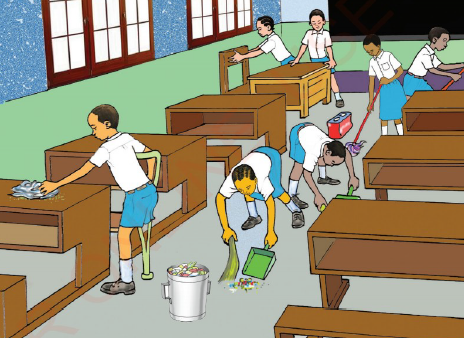 |
| Figure 5 Pupils cleaning the classroom |
Exercise
1. Mention the activities shown in Figure 5.
2. Mention other cleanliness activities which are not shown in Figure 5.
3. Mention the tools used to clean the classroom.
4. What happens if the classroom is not clean?
5. What are the advantages of cleaning your classroom?
Classroom cleanliness competitionRead the following passage and then answer the questions in Exercise 2.
The name of our school is Juhudi Primary School. We have a classroom cleanliness competition every Friday. Such competitions are done after the lessons.
Last Friday, we worked together in cleaning our classroom. As we were cleaning, Juma said, "It is important to clean our classroom to make it attractive."
Hallma took a broom with a long handle and started to remove cobwebs. John said to Halima, "You have done a good job to remove cobwebs. Cobwebs pollute our classroom environment." John added, "Garbage is a shelter for mosquitoes and other organisms." Then Dotto said, "If we do not remove these shelters, mosquitoes will bite us. They will infect us with malaria. "
After that, Helena took a piece of cloth and began to remove dust, while saying, "We should remove dust to avoid making our clothes dirty." Mariam and Faraja cleaned the teacher's table, chair and book shelf. Afterwards, we all worked together to mop the classroom floor. We used a piece of cloth, water and soap. Then we arranged our desks properly. We made sure there was enough space between one desk and another.
Teachers and prefects came to inspect our classroom. We won the competition. We were awarded a shield. We were very happy. We agreed that we should clean our classroom every day.
Answer the following questions.
1. Which tools were used to clean the classroom at Juhudi Primary School?
2. List the disadvantages of an unclean classroom.
3. Why did the Standard Three pupils win the cleanliness competition?
4. Why is it important to arrange desks properly?
5. Mention four advantages of cleaning your classroom.
6. Mention steps to follow when cleaning a classroom.
7. Describe how a clean class looks like.
Study Figure 6 then answer the questions.
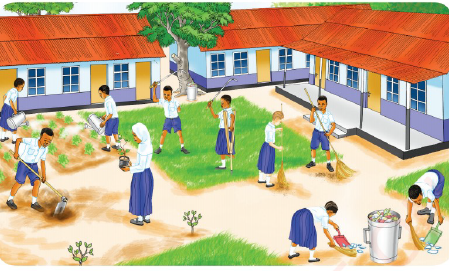 Figure 6 Pupils cleaning the school compound |
Questions
l . Which activities that protect the environment do you see in Figure 6?
2. Which tools are used to keep the environment clean?
3. Mention environmental protection activities at your school other than those shown above.
4. Why should we keep our school compound clean?
Environmental cleanliness at Juhudi Primary School
Read the following passage and answer the questions in Exercise 3.
Amani is a Standard Three pupil at Juhudi Primary School. Pupils of Juhudi Primary School have good discipline. Amani and his fellow pupils arrive at school at 6:30 in the morning.
After arriving at school, they start cleaning the school compound. They work together. They pick pieces of paper and put them in garbage bins.
They sweep the school pathways. Then, they cut long grass by using stashers. Other pupils weed flower beds using hoes. They also water flowers and other plants. After this cleaning, they go to the assembly ground. They listen to announcements from their teachers. Then they go to their classrooms.
Exercise 3
1. What cleanliness activities, other than those mentioned, can be done at school?
2. List the tools used to clean the school compound.
3. What cleaning activities are done by Amani and his fellow pupils at school?
Planting trees, grass, and flowersTrees, grass, and flowers are attractive plants in our environment. They beautify the environment and produce fresh air as well as scents. When the environment lacks trees, grass and flowers, it may turn into a desert. An environment with scents attracts insects such as butterflies and bees. Bees produce honey.
Read the following conversation about the stages of planting trees, grass, and flowers.
| Dotto | Hamis, I passed by your school and saw flowerbeds, grass, and trees. They are very attractive. |
| Hamis | Of course. In our school, there are flowerbeds, grass, and trees. They provide fresh air and scents. |
| Dotto | Ooh! How did you manage to have such a beautiful environment? |
| Hamis | We started with an idea about the kind of grass, flowers and trees we wanted to plant. |
| Dotto | Oooh! Tell me more. |
| Hamis | First, make sure you choose a fertile area to plant your grass, trees, and flowers. |
| Dotto | This is a great idea! I like it. |
| Hamis | That is not all. You should also clean up the area. The area should be ready for planting trees, grass, and flowers. |
| Dotto | I really enjoy this knowledge. What are the next steps? |
| Hamis | You should improve the soil fertility by mixing it with manure before planting. |
| Dotto | Wow Hamis! What do you do next? |
| Hamis | We till the land and choose the seedlings we need. Then we plant them. |
| Dotto | I get you! That is why your school environment is attractive. |
| Hamis | We also look after the blocks of plants, grass and flowers by watering them whenever necessary. We use insecticides on all the blocks. This prevents insects from destroying the plants, grass and flowers. |
| Dotto | I thank you for this knowledge. I promise you that I will inform my teacher about it. We will then visit your school to learn more. |
Activity 2
Choose one activity for keeping the environment clean and do it at your school.
a) Preparing flower beds
b) Watering trees, grass, and flowers
c) Cleaning the school compound by sweeping, mopping, and weeding flower beds
d) Educatin ils on environmental conservation
The advantages of a clean environmentA clean environment is good for our health. So, it is important to clean the school environment to remove harmful organisms. These organisms include flies, mosquitoes, rats and snakes. They hide in dirty areas and cause diseases such as malaria, cholera, dysentery, plague and typhoid. A clean environment also prevents insects and germs from destroying food and crops in farms and homes.
Answer the following questions.
1. What is the environment?
2. List activities that pollute your school environment.
3. Give reasons for cleaning your school environment. Describe the disadvantages of an unclean school environment.
5. Describe the stages of preparing areas for planting flowers, grass and trees.
6. List all dangerous organisms which hide in dirty environments.
7. Mention activities which can be done to keep your school environment clean.
8. Explain the importance of planting flowers, trees, and grass in the school environment.
Choose the most correct answer and write it in the space provided.
9. Things which are found in the environment are divided into two parts. These are .
- living and non-living organisms.
- plants and animals.
- advantageous and harmful organisms.
1 0. A dirty environment can cause
- hunger among people.
- spread of diseases.
- war among people.
What will happen if the school environment is not conserved?
Vocabulary
| Cobweb | a net-like structure of sticky silk thread made by spiders as a living space and insect trap |
| Conservation | keeping or protecting something in a good way for use now and in future |
| Conversation | a talk between two or more people |
| Domestic animals | animals that are kept at home for food and other uses |
| Environment | surroundings/everything around us, including living and non-living things |
| Environmental pollution | putting harmful things such as poisonous chemicals into water and soil |
| Garbage | waste or unwanted things that you throw away |
| Garden | a piece of land planted with flowers, fruits and vegetables |
| Graduation | a ceremony at which certificates are awarded to school or college leavers after they have completed their studies |
| Handover | giving something to someone else |
| Micro-organism | a very small creature which cannot be seen by our naked eyes, but by using a microscope |
| Mop | a cleaning material fixed to a long handle for cleaning the floor using water |
| Shield | something which is given as a prize for winning a competition |
| Skill | knowledge of doing something in a an intelligent way |
| Tilling | a method of preparing land for planting crops by using hand tools |
| Water well | a hole for drawing water from the ground |
| Wild animals | animals which live in the bush or in the forest |
www.learninghubtz.co.tz
Hub App
 For Call,Sms&WhatsApp: 255769929722 / 255754805256
For Call,Sms&WhatsApp: 255769929722 / 255754805256
 For Call,Sms&WhatsApp: 255769929722 / 255754805256
For Call,Sms&WhatsApp: 255769929722 / 255754805256
WHATSAPP US NOW FOR ANY QUERY
App Ya Learning Hub Tanzania






